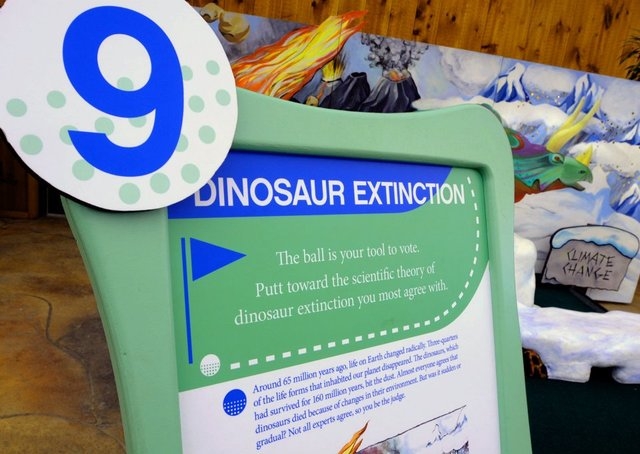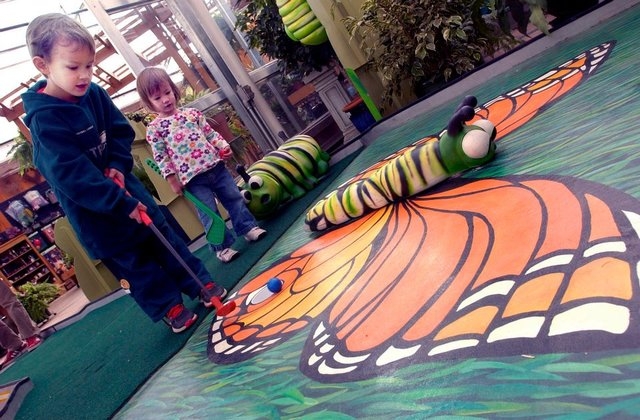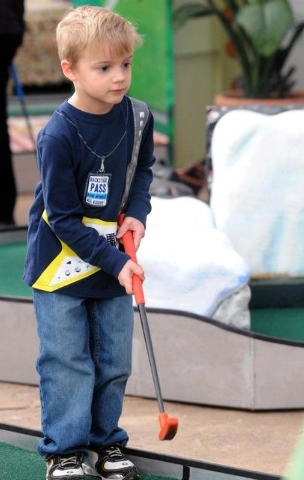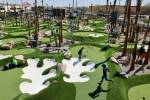‘Fore! The Planet’ an educational activity for participants
There are holes where the player has to putt the ball through something, and holes where the player has to putt the ball around something and holes where the player has to putt the ball over something.
But, what, no windmill?
It’s the only classic miniature golf hazard that “Fore! The Planet” is lacking. But when the combination miniature golf/educational exhibit begins a summerlong run at the Springs Preserve’s Origen Museum this weekend, the unusual twist given to each of its 18 holes will more than make up for it.
“Fore! The Planet” opens to the general public Sunday. Guests may play the course during regular Springs Preserve hours through Sept. 1 with no charge beyond general admission. For more information, visit www.springspreserve.org or call 702-822-7700.
Not only is “Fore! The Planet” the most unusual-looking miniature golf course around — and in a city where aficionados of the game can play a course devoted to the rock band Kiss, that’s saying something — it’s designed with a purpose in mind: To educate players about the natural world.
Each hole focuses on a scientific concept about the Earth or the creatures and plants that live upon it. At one hole, the player’s golf ball represents the dispersal of a seed from the fruit of a tree and asks golfers to “feed” the ball to one of three creatures that might best disperse that seed. Another hole illustrates how bats use sonar to navigate by having the ball represent the bat and asking golfers to use a noise coming from inside a “cave” to get the ball to the cup.
At still another hole, the golfer’s ball stands in for a housefly attempting to reach safety as it avoids predators, while another hole asks golfers to putt through an ecosystem to illustrate the creatures and plants that live in the typical backyard.
Even evolution receives a miniature golf overlay by asking golfers to putt through geologic eras to see how the modern golfer has evolved, while a hole devoted to dinosaurs presents three theories of dinosaurs’ extinction and asks golfers to putt toward the one that seems most likely.
Oh, and don’t succumb to the water hazard, because that hole is devoted to explaining water pollution.
Textual materials outline each scientific concept, giving both miniature golf and science instruction a different spin.
“It’s a lot of fun,” says Emmi Saunders, assistant curator at the Springs Preserve, noting that the interactive theme of the show also extends to asking golfers to read about a concept and then make a decision about it.
“There are definitely choices along the way,” she says.
The exhibit is suitable for ages 3 or 4 “up through grandparents,” Saunders says. “Basically, as soon as (kids) can hold a golf club, they’re welcome.”
In addition to teaching about biological sciences, evolution, natural selection and other concepts, the exhibit/course explores how humans interact, for good or bad, with the natural world. For example, one hole asks golfers to think of their ball as an animal trying to cope with such man-made obstacles as pipelines and property development.
“So it’s great because it looks at how what we do has an impact,” Saunders says.
By the way, families that don’t make miniature golf part of their regular entertainment menu needn’t worry. Volunteers will be on-hand “to help them get involved and give them a quick explanation of how to move through,” Saunders says.
Saunders says combining science with miniature golf can be an effective way to teach scientific concepts. “I think any time you combine fun with learning, you’re more successful,” she says.
“Plus, I think this is an opportunity for families and kids to cooperate and work together, to just have that experience of working with your family — your siblings, your aunts, uncles, whoever happens to come with you. It makes it an experience and an opportunity to learn.”
“I mean, there’s kind of a universal appeal,” Saunders says. “It’s miniature golf, and who doesn’t like that? And, it’s indoors, so you get out of the heat.”
So about that windmill: Wouldn’t it be a natural for, maybe, a hole about wind power and alternative energy? And wouldn’t that be cool?
Saunders laughs. “That would be,” she answers in what sounds suspiciously like that voice mothers use at the Springs Preserve when their kids are getting a bit too wound-up. “It would be nice.”
Contact reporter John Przybys at jprzybys@reviewjournal.com or 702-383-0280
Preview
What: Fore! The Planet
When: 10 a.m. to 6 p.m. daily, Sunday through Sept. 1
Where: Springs Preserve, 333 S. Valley View Blvd.
Tickets: $10.95-$18.95 nonresidents, $4.95-$9.95 residents, children younger than 5 free (www.springspreserve.org or 702-822-7700)































